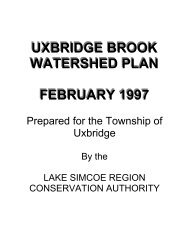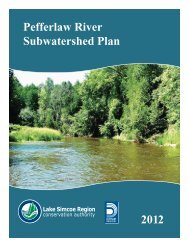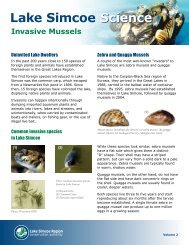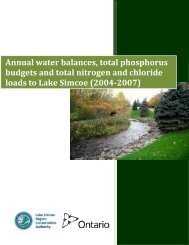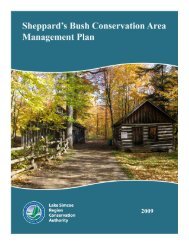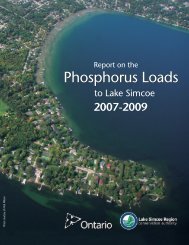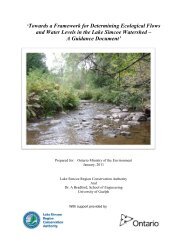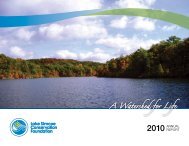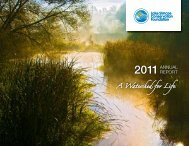Barrie Creeks, Lovers Creek, and Hewitt's Creek Subwatershed Plan
Barrie Creeks, Lovers Creek, and Hewitt's Creek Subwatershed Plan
Barrie Creeks, Lovers Creek, and Hewitt's Creek Subwatershed Plan
You also want an ePaper? Increase the reach of your titles
YUMPU automatically turns print PDFs into web optimized ePapers that Google loves.
The <strong>Barrie</strong> <strong><strong>Creek</strong>s</strong>, <strong>Lovers</strong> <strong>Creek</strong> <strong>and</strong> Hewitt’s <strong>Creek</strong> <strong>Subwatershed</strong> <strong>Plan</strong><br />
2.5 Fluvial Geomorphology<br />
2.5.1 Introduction <strong>and</strong> background<br />
Fluvial geomorphology is the study of the processes that influence the shape <strong>and</strong> form of<br />
streams <strong>and</strong> rivers. It describes the processes whereby sediment <strong>and</strong> water are transported<br />
from the headwaters of a watershed to its mouth. These processes govern <strong>and</strong> constantly<br />
change the form of the river <strong>and</strong> stream channels, <strong>and</strong> determine how stable the channels are.<br />
Fluvial geomorphology provides a means of identifying <strong>and</strong> studying these processes, which are<br />
dependent on climate, l<strong>and</strong> use, topography, geology, vegetation, <strong>and</strong> other natural <strong>and</strong> human<br />
influenced changes.<br />
An extensive underst<strong>and</strong>ing of geomorphic processes <strong>and</strong> their influences is required in order to<br />
protect, enhance, <strong>and</strong> restore stream form in a watershed. Changes in l<strong>and</strong> use, <strong>and</strong><br />
urbanization in particular, can significantly impact the movement of both water <strong>and</strong> sediment,<br />
<strong>and</strong> can thus cause considerable changes to the geomorphic processes in the watershed.<br />
Changes to the morphology of stream channels, such as accelerated erosion, can impact the<br />
aquatic community, which has adapted to the natural conditions, <strong>and</strong> can also threaten human<br />
lives, property, <strong>and</strong> infrastructure.<br />
2.5.2 Geomorphic Processes<br />
All streams <strong>and</strong> river systems are constantly in a state of transition, influenced by the flow of<br />
water <strong>and</strong> the amount of sediment entering into the system, which in turn are influenced by<br />
climate <strong>and</strong> geology. The amount of water delivered to the surface of a watercourse, as well as<br />
how <strong>and</strong> when it arrives is influenced by climate. Typical patterns are high flow events during<br />
the spring freshet, <strong>and</strong> low flow conditions during the winter <strong>and</strong> summer months.<br />
The surficial geology of an area influences the path of water once it reaches the ground surface.<br />
The underlying geology establishes the volume <strong>and</strong> proportion of groundwater <strong>and</strong> surface<br />
water available to flow through a watershed through its effect on infiltration. Geology also<br />
shapes the amount <strong>and</strong> type of sediment that enters a watercourse, <strong>and</strong> the strength <strong>and</strong><br />
erodibility of the surficial material through which the watercourse flows. A complex underlying<br />
geology <strong>and</strong> topography can result in considerable variation in channel character, as well as<br />
sensitivity to potential impacts, within the same drainage system.<br />
Natural watercourses respond to continually changing conditions in flow <strong>and</strong> sediment supply<br />
with adjustments in shape <strong>and</strong> channel position. These changes take place through the<br />
processes of erosion <strong>and</strong> deposition. This ability to continually change is an inherent<br />
characteristic of natural systems that allows the morphology of the channels to remain relatively<br />
constant. The state in which flow <strong>and</strong> sediment supply are balanced to achieve this stable<br />
channel form is referred to as “dynamic equilibrium.” While in a state of dynamic equilibrium,<br />
channel morphology is stable but not static, since it<br />
makes gradual changes as sediment is eroded,<br />
deposited, <strong>and</strong> moved throughout the watercourse. For<br />
example, many natural watercourses can be seen to<br />
“migrate” within their floodplain over time. This is due to<br />
the erosion of the outsides of channel bends, but with<br />
corresponding deposition of material on the insides of<br />
bends. This process maintains the balance between flow<br />
<strong>and</strong> sediment supply in the system. Riparian <strong>and</strong> aquatic<br />
biota are adapted to <strong>and</strong> depend on the habitats provided<br />
by a system in dynamic equilibrium.<br />
Chapter 2: Study Area: The <strong>Barrie</strong> <strong><strong>Creek</strong>s</strong>, <strong>Lovers</strong> <strong>Creek</strong> <strong>and</strong> Hewitt’s <strong>Creek</strong> <strong>Subwatershed</strong>s 58





